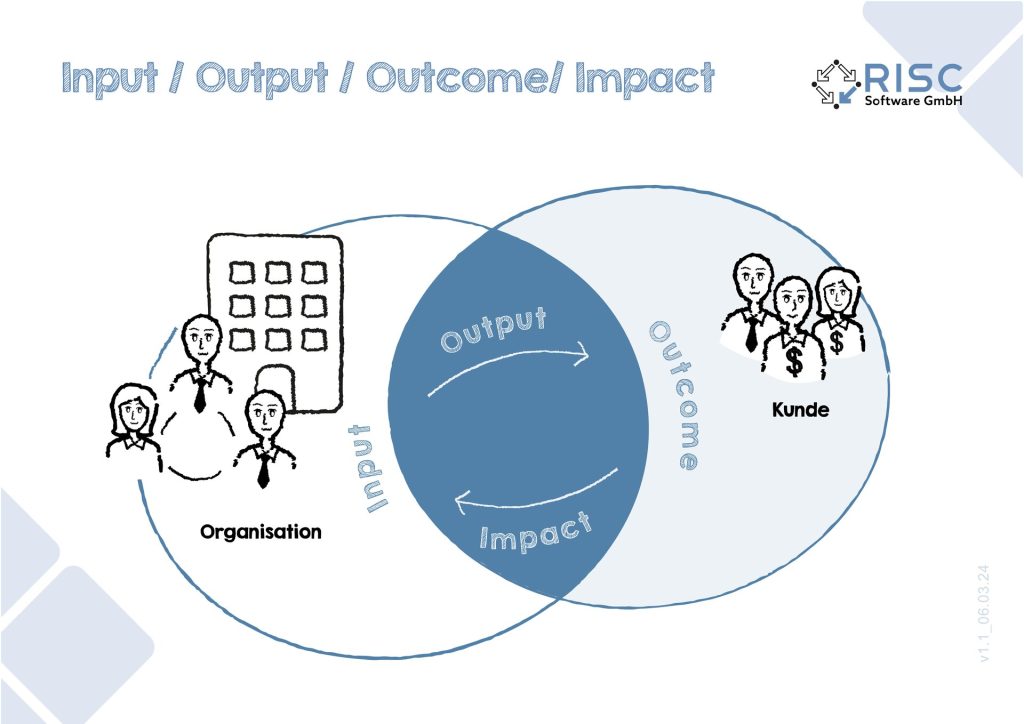Die Essence of Outcome
The Importance of Outcome in Generating Value from Software Products.
by DI (FH) Andreas Lettner
The evaluation of software products traditionally relies on various levels: Input, Output, Outcome, and Impact. These levels are closely interconnected and play a crucial role in generating the value of a product. In practice, there is often a focus on Input and Output, while the significance of Outcome is overlooked. This report examines the dependencies between these levels and emphasizes the importance of an outcome-focused approach.
Content
- What are Input, Output, Outcome, and Impact?
- Why not Output?
- How to work in an outcome-focused way?
- Additional support through a purpose
- Conclusion
- Author

What are Input, Output, Outcome, and Impact?
Input refers to the resources invested in the development of a software product, including time, money, expertise, and technology. Metrics to measure Input can include development time, budget allocation, team size, and technical complexity.
Output describes the immediate results of development activities and relates to the features of the product and services created or provided. Metrics such as the number of features developed, lines of code, number of bugs, and extent of documentation can be used here.
Outcome refers to the actual changes (including behavioral changes) or improvements that a product achieves for users or its environment. Metrics to measure Outcome can include user satisfaction, user acceptance, usage frequency, conversion rates, time savings, and efficiency improvements.
Impact finally refers to the long-term consequences or effects of the product on the entire organization, industry, or society. Metrics such as revenue increases, cost savings, market share gains, innovations, or customer retention can be used here.

Why not Output?
A focus solely on Output may be appealing for evaluating productivity but is not goal-oriented. Output metrics merely quantify the immediate results of development activities without considering the actual effects on users or the environment. These metrics can provide important information about what was produced but say nothing about the quality, usefulness, or long-term benefits of the product. Without focusing on Outcome, companies risk developing products with many features or technical sophistication but ultimately fail to meet users’ needs or create desired changes. This can lead to misinvestments, low user acceptance, and lack of competitiveness. Therefore, companies should adopt a holistic approach that considers not only Output but also the desired Outcome and long-term Impact.
How to Work in an Outcome-Focused Way?
An outcome-focused approach means prioritizing the actual benefits and added value for users during product development. This approach requires continuous evaluation and adjustment to ensure that the product delivers the desired results. Unfortunately, this approach is often neglected in practice, as companies focus on developing and delivering products without adequately considering their long-term effects on users or the environment.
Agile methods provide a framework that facilitates Outcome focus. Through iterative development cycles and close collaboration with stakeholders, including end-users, agile methods enable continuous validation and adaptation of the product based on actual benefits and user needs. Involving users in the development process allows early feedback to ensure that the product delivers the desired results.
Evidence-Based Management (EBM) is another approach that can support software product development. EBM refers to using empirical data and validated insights to make management decisions. This means that decisions should be based on evidence rather than assumptions or personal opinions. By applying EBM, companies can make more informed decisions and minimize risks by relying on real data and experiences.
Additional Support Through a Purpose
The close connection between Outcome and Purpose is a key aspect of generating value from software products. The Purpose, or the intent of the product, is crucial for clearly defining the desired Outcome. A well-defined Purpose helps direct the focus toward creating purpose-driven outcomes.
Lack of alignment here can lead to inefficiency, product misalignment, and low user acceptance. Therefore, it is important for companies to clearly and explicitly define the Purpose of their product and ensure that the desired Outcome aligns with it.
Conclusion
Focusing on Outcome is crucial for generating value from software products and achieving long-term Impact. It allows companies to ensure that their products deliver the desired improvements for users and their environment. By concentrating on Outcome, companies can achieve long-term positive effects beyond short-term Output metrics. If companies focus solely on Input and Output, they risk losing sight of their product’s real value and failing to achieve long-term effects. An Outcome-focused approach enables companies to continuously improve their products by addressing the real needs and requirements of their users, thereby achieving long-term positive impacts on the organization, industry, and society as a whole.
Contact Person
Author

DI (FH) Andreas Lettner
Chief Product Officer,
Head of Unit Domain-specific Applications


